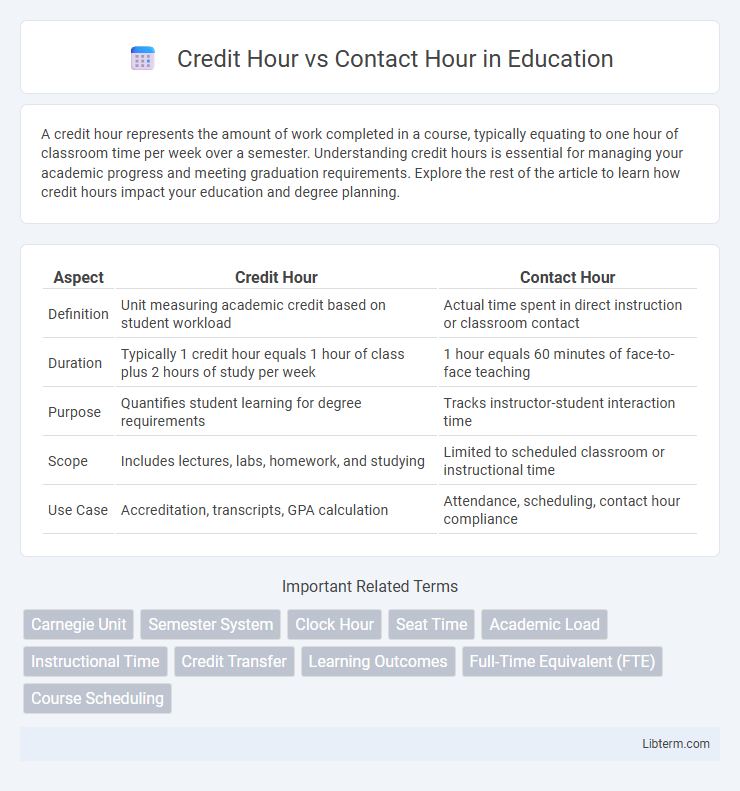A credit hour represents the amount of work completed in a course, typically equating to one hour of classroom time per week over a semester. Understanding credit hours is essential for managing your academic progress and meeting graduation requirements. Explore the rest of the article to learn how credit hours impact your education and degree planning.
Table of Comparison
| Aspect | Credit Hour | Contact Hour |
|---|---|---|
| Definition | Unit measuring academic credit based on student workload | Actual time spent in direct instruction or classroom contact |
| Duration | Typically 1 credit hour equals 1 hour of class plus 2 hours of study per week | 1 hour equals 60 minutes of face-to-face teaching |
| Purpose | Quantifies student learning for degree requirements | Tracks instructor-student interaction time |
| Scope | Includes lectures, labs, homework, and studying | Limited to scheduled classroom or instructional time |
| Use Case | Accreditation, transcripts, GPA calculation | Attendance, scheduling, contact hour compliance |
Understanding Credit Hours: Definition and Purpose
Credit hours quantify the amount of academic work a student completes, representing the expected time spent on coursework each week throughout a semester. They serve as a standard measure for awarding degrees and determining tuition fees based on the total academic workload. Unlike contact hours, which refer strictly to actual classroom or instruction time, credit hours encompass both in-class learning and independent study.
What Are Contact Hours? Key Differences Explained
Contact hours refer to the actual time students spend attending classes, laboratories, or other instructional activities, typically measured in minutes or hours per week throughout a semester. Unlike credit hours, which quantify the total academic credit earned based on coursework completion, contact hours emphasize direct interaction with instructors and participation in scheduled learning sessions. Key differences include that contact hours track in-person instructional time, while credit hours integrate both contact time and expected independent study, influencing how institutions structure course loads and graduation requirements.
Historical Origins of Credit and Contact Hours
Credit hours originated in the early 20th century as a standardized measure to quantify student workload and academic progress, often linked to Carnegie Unit definitions that emphasized weekly study time. Contact hours historically referred to the actual time students spend in direct interaction with instructors during lectures or labs, rooted in traditional classroom schedules established in the late 19th century. The differentiation between credit and contact hours evolved to balance measured instructional time with expected independent study, forming the basis of modern academic credit systems.
Academic Impact: Credit Hour vs Contact Hour
Credit hours quantify the amount of academic credit a student earns for completing a course, reflecting learning outcomes and mastery of material, whereas contact hours measure the actual time spent in direct instruction or classroom activities. Understanding the distinction is crucial for curriculum design, as credit hours influence degree requirements, student workload, and academic progression, while contact hours impact faculty teaching loads and scheduling. Accurate alignment of credit hours with contact hours ensures academic rigor and compliance with accreditation standards.
How Institutions Calculate Credit and Contact Hours
Institutions calculate credit hours based on the amount of work a student is expected to complete, typically one credit hour representing one hour of classroom instruction and two hours of outside study per week over a semester. Contact hours refer to the actual time a student spends in direct interaction with instructors during lectures, labs, or discussions, often logged by attendance or institutional scheduling systems. The distinction ensures accurate measurement of academic workload, with credit hours reflecting total student effort and contact hours representing face-to-face instruction time.
Credit Hours and Degree Requirements
Credit hours measure the amount of academic credit awarded for completing a course, typically reflecting the total student workload including lectures, assignments, and study time. Degree requirements often specify a minimum number of credit hours needed for graduation, ensuring students acquire sufficient knowledge across core and elective subjects. Accumulating the required credit hours validates a student's progress toward fulfilling the curriculum and earning a degree.
Contact Hours in Clinical and Laboratory Settings
Contact hours in clinical and laboratory settings represent the actual time students spend engaging directly with hands-on training, essential for developing practical skills in healthcare education. Unlike credit hours that quantify overall academic workload, contact hours emphasize real-time supervised practice, simulation, and patient interaction required for competency in clinical procedures. Accurately tracking contact hours ensures students meet accreditation standards and gain sufficient experiential learning critical for professional licensure.
Importance for Accreditation and Compliance
Accreditation agencies prioritize credit hours as key indicators of academic workload and learning outcomes, ensuring programs meet established educational standards. Contact hours represent the actual classroom or direct instruction time, supporting compliance with institutional policies and regulatory requirements. Both metrics are critical for maintaining accreditation status and demonstrating adherence to quality assurance and federal regulations in higher education.
International Perspectives: Credit vs Contact Hours
Credit hours represent the total amount of academic work including classroom instruction, assignments, and independent study, typically used in the United States to quantify student workload. Contact hours measure the actual time spent in direct instruction between students and instructors, a common metric in European and Asian education systems. Internationally, universities often reconcile these differences by converting contact hours to credit hours for credit transfer and program equivalency, with one credit hour frequently equating to one hour of classroom instruction plus additional study time.
Optimizing Study Plans: Navigating Both Hour Systems
Understanding the difference between credit hours and contact hours is essential for optimizing study plans in higher education. Credit hours represent the amount of academic credit earned, reflecting both in-class time and expected out-of-class study, while contact hours strictly measure the actual time spent in direct instruction. Balancing these systems helps students allocate appropriate study time, ensuring efficient learning and meeting graduation requirements.
Credit Hour Infographic

 libterm.com
libterm.com